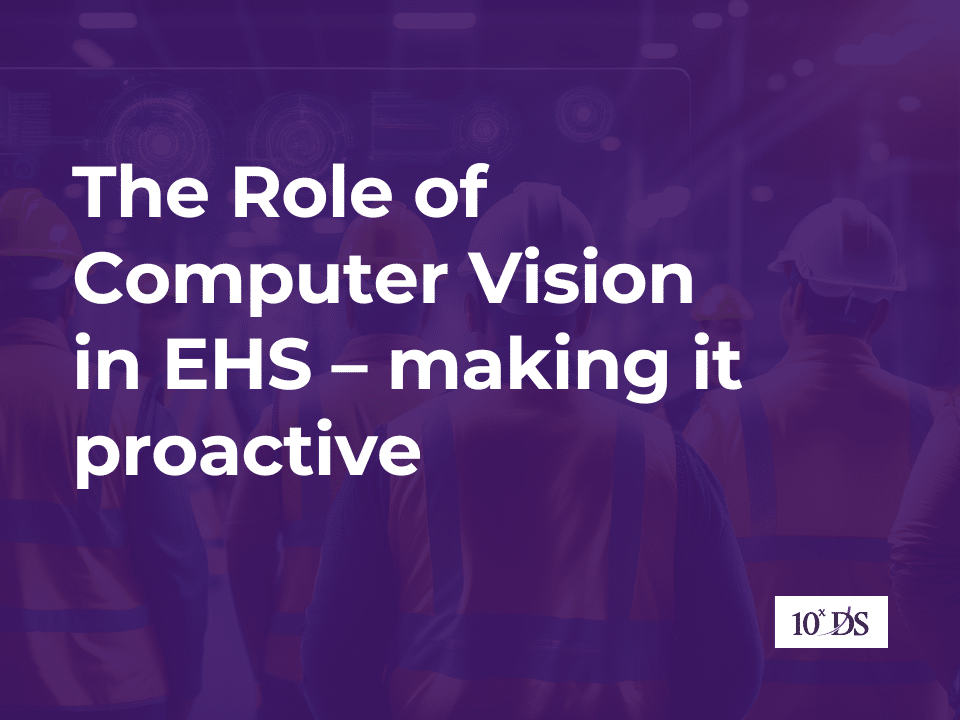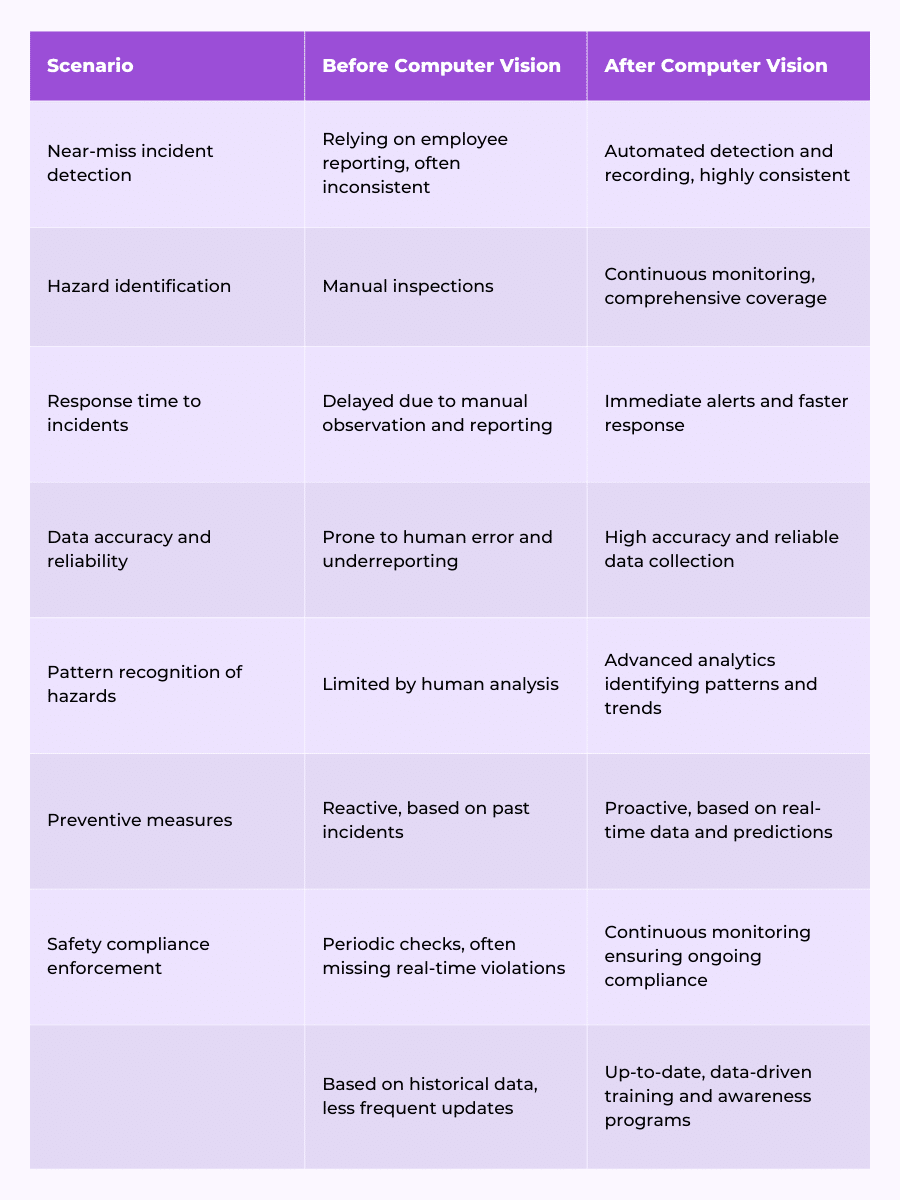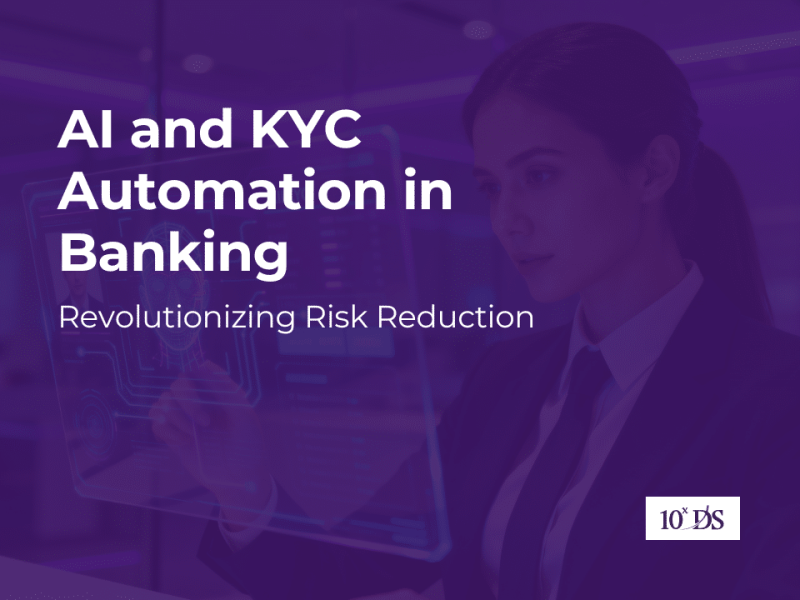
The Role of Computer Vision in EHS – making it proactive
Near-miss incidents in workplaces used to be often undocumented or unnoticed, primarily due to the limitations of human observation and traditional monitoring methods. These incidents, which are potential accidents narrowly avoided, serve as crucial indicators of underlying safety hazards. Without comprehensive documentation and analysis, patterns of unsafe conditions or behaviors remained undetected, making it challenging to implement effective preventive measures. The reliance on manual reporting led to inconsistencies and gaps in data, leaving safety management systems less effective. Consequently, workplaces may have been perceived as safer than they actually were, as the absence of reported incidents did not necessarily equate to the absence of risks. The introduction of computer vision has revolutionized this aspect by providing continuous, objective, and detailed monitoring, enabling the identification and mitigation of hazards before they result in accidents.
The table below highlights how computer vision enhances various aspects of employee health and safety by providing continuous, accurate, and real-time monitoring and data analysis.

The Employee Health and Safety (EHS) function is the best area for the transformative impact of computer vision (CV) because it addresses critical needs for workplace safety, compliance, and efficiency in ways that traditional methods cannot match. Let us explore this in detail below.
Enhanced Hazard Detection and Incident Prevention
CV systems revolutionize hazard detection and incident prevention by providing continuous monitoring of the workplace. Unlike human observers, who can become fatigued and miss potential hazards, CV systems maintain constant vigilance, ensuring that potential risks are detected in real-time. When a potential hazard is identified, CV systems can trigger immediate alerts, allowing for swift intervention and preventing incidents before they occur. This proactive approach significantly reduces the occurrence of accidents and near-miss events. Additionally, CV systems use advanced analytics to analyze video feeds and identify patterns and trends that may indicate recurring safety issues. By addressing these root causes, EHS professionals can implement more effective preventive measures, ultimately creating a safer work environment.
Improved Compliance and Documentation
CV systems play a crucial role in enhancing compliance and documentation within the EHS function. These systems continuously monitor compliance with safety protocols, such as the use of personal protective equipment (PPE) and adherence to safety zones. Any deviations from established protocols are immediately flagged, ensuring that employees maintain compliance at all times. Furthermore, CV systems generate accurate and comprehensive records of safety-related incidents and compliance checks. This automated documentation is far more reliable than manual records, reducing the risk of human error. The detailed data collected by CV systems can be analyzed to produce insights and reports that help EHS professionals understand safety performance and identify areas for improvement. This data-driven approach leads to more informed decision-making and enhances overall workplace safety.
Enhanced Training and Awareness
The implementation of CV systems also enhances training and awareness among employees. The detailed incident data captured by CV can be used to create realistic training scenarios, improving employees’ preparedness for actual safety risks. CV systems can provide immediate feedback to employees on their safety practices, reinforcing safe behavior in real-time. For example, if an employee enters a restricted area without proper PPE, the system can alert them instantly. This immediate feedback helps employees correct their behavior promptly. Moreover, with continuous data collection and analysis, EHS teams can regularly update and refine training programs, ensuring that employees are always aware of the latest safety protocols and best practices. This ongoing education fosters a culture of safety and vigilance, ultimately contributing to a safer workplace.
The future of the Employee Health and Safety (EHS) function with the integration of computer vision (CV) promises to be transformative, driving unprecedented levels of safety, compliance, and efficiency. CV will enable continuous, real-time monitoring of workplaces, allowing for immediate detection and response to hazards, thereby preventing accidents before they occur. Advanced analytics will uncover patterns and trends, leading to proactive risk management and informed decision-making. Automated compliance monitoring will ensure adherence to safety protocols, reducing the risk of violations and enhancing overall workplace safety. The wealth of data generated by CV systems will refine training programs, making them more effective and relevant. As CV technology evolves, it will further integrate with other innovations like AI and IoT, creating a comprehensive, interconnected safety ecosystem that not only safeguards employees but also optimizes operational efficiency and fosters a culture of continuous improvement. This integration will ultimately redefine the EHS function, making workplaces safer, smarter, and more resilient.
Talk to our experts to learn more.


